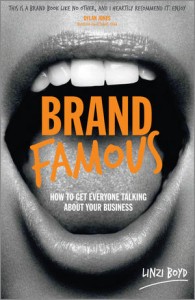Brand famous

About the author
Richard Bailey Hon FCIPR is editor of PR Academy's PR Place Insights. He teaches and assesses undergraduate, postgraduate and professional students.

Brand books are dime-a-dozen, so why read this one?
For one thing, author Linzi Boyd is a perfect example of a self-made man (being female doesn’t disqualify her). She dropped out of school at 15 then built successful retail and footwear businesses before setting up a communications agency, Surgery, aged 25.
(‘I saw a gap in the market for an agency that was down to earth, normal and would produce exactly what it said on the tin… Surgery has evolved over the last 15 years, from a small, one-man band PR and marketing agency into a full service communications agency.”)
Communications is key to getting everyone talking about your brand, and Boyd recommends consistency across channels:
“If you want your brand values to reach your target audience and cement your brand into the psyche of the people, then keep providing them with the same message dressed up in different clothes, over and over again through the strategic channels that you have chosen.”
No single channel (such as advertising or celebrity placement) is sufficient. “To be in the top 10% of brands you have to look at more than one or two channels of communication.”
She’s an advocate of public relations, which she describes as “the act of creating a strategy, sending out product, schmoozing the journalists and getting the product to grace the pages of every single relevant publication, worn on your favourite celebs and talked about by all the people in the know so that the product literally walk off the shelves. All for free…”
This is a limited view of PR, relevant only to business-to-consumer companies, but it’s one designed to appeal to business owners and marketing managers for whom the low cost and improved credibility of editorial coverage over advertising placement should be attractive.
The book is based on Boyd’s five step ‘surgical operation’ for building or renovating brands.
- Step one is ‘discover’: the process of exploring brand values and key messages.
- Step two is ‘create’: this involves creating the product lines that fit with the brand values, and preparing to create awareness around them.
- Step three is ‘connect’: this may involve retail channels, and is also about connecting to target audiences.
- Step four is ‘communicate’: producing and implementing a communications plan covering marketing and PR.
- Step five is ‘evaluate’: about knowing your KPIs from your ROI.
For the purposes of this review, we’ll take a closer look at the ‘communicate’ step.
Her five ‘touchpoints’ for creating successul conversations are: traditional print, social media and digital engagement, brand partnerships/collaborations, retail engagement and experiential events. ‘All five are important and all must be included as part of your communications offering.’
An example of an experiential talking point was Surgery’s campaign for Desigual in which anyone attending the Oxford Street store wearing nothing but their underwear on a given day would receive a free Desigual outfit.
Despite torrential rain on the day, the queue of semi-naked people ran round the corner into Regent Street and the event was widely discussed online and in the news. The stores saw an increase in sales on the day and in the coming weeks and gained an impressive increase in followers on Facebook and Twitter.
There’s an interesting overlap between the world of fashion and technology in the section on social media. Here Boyd suggests that ‘Once Google+ takes off it will become a must-have, a bit like a Mulberry handbag.’
One thing the image of the book cover doesn’t convey is just how bright the flourescent orange is. It’s widely used in boxes and highlights throughout the text and the book is a visual treat.
It may not have many lessons for students of marketing or PR (or their lecturers), but it’s a practical book designed to appeal to business owners who may, like the author, have left education early.